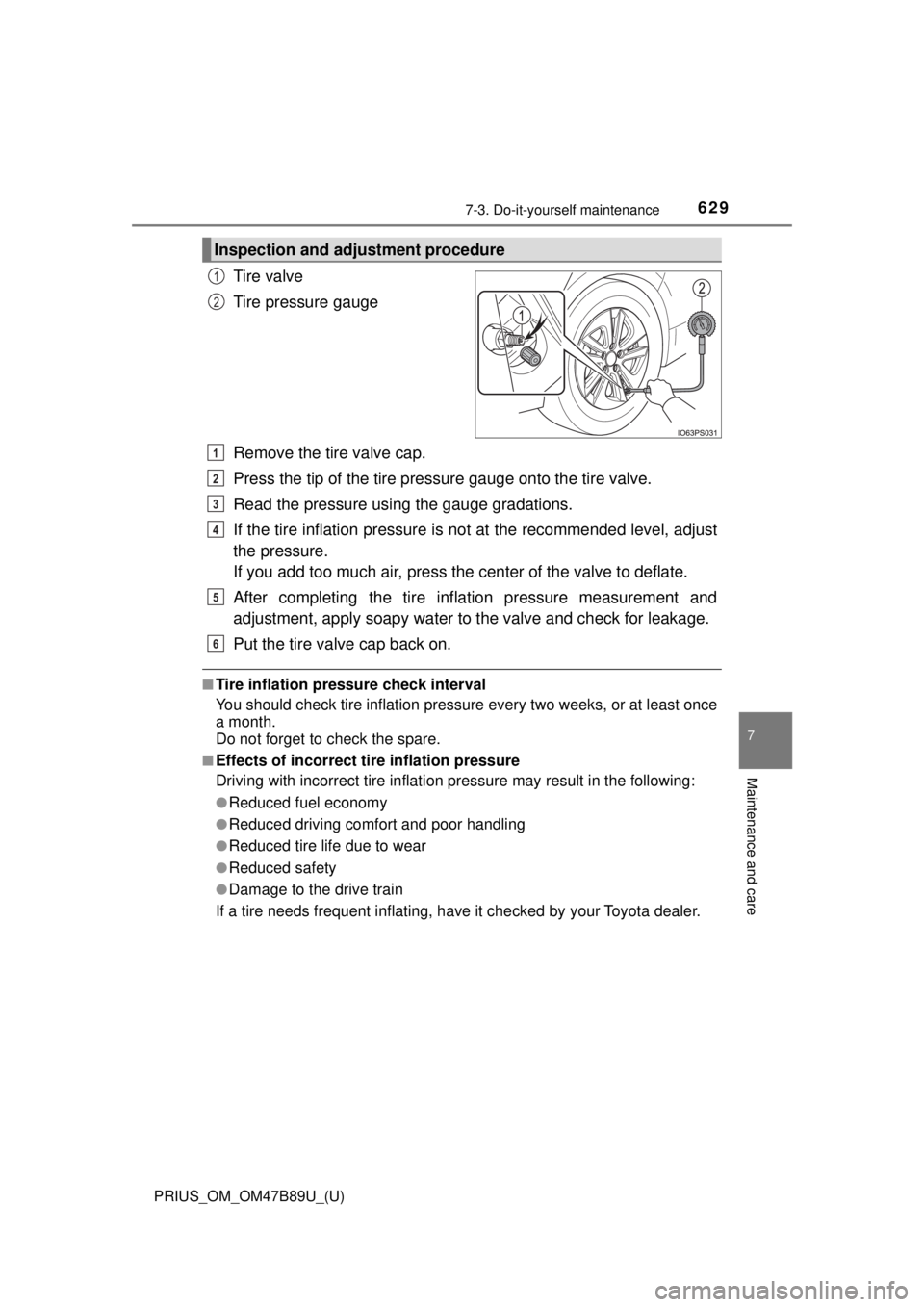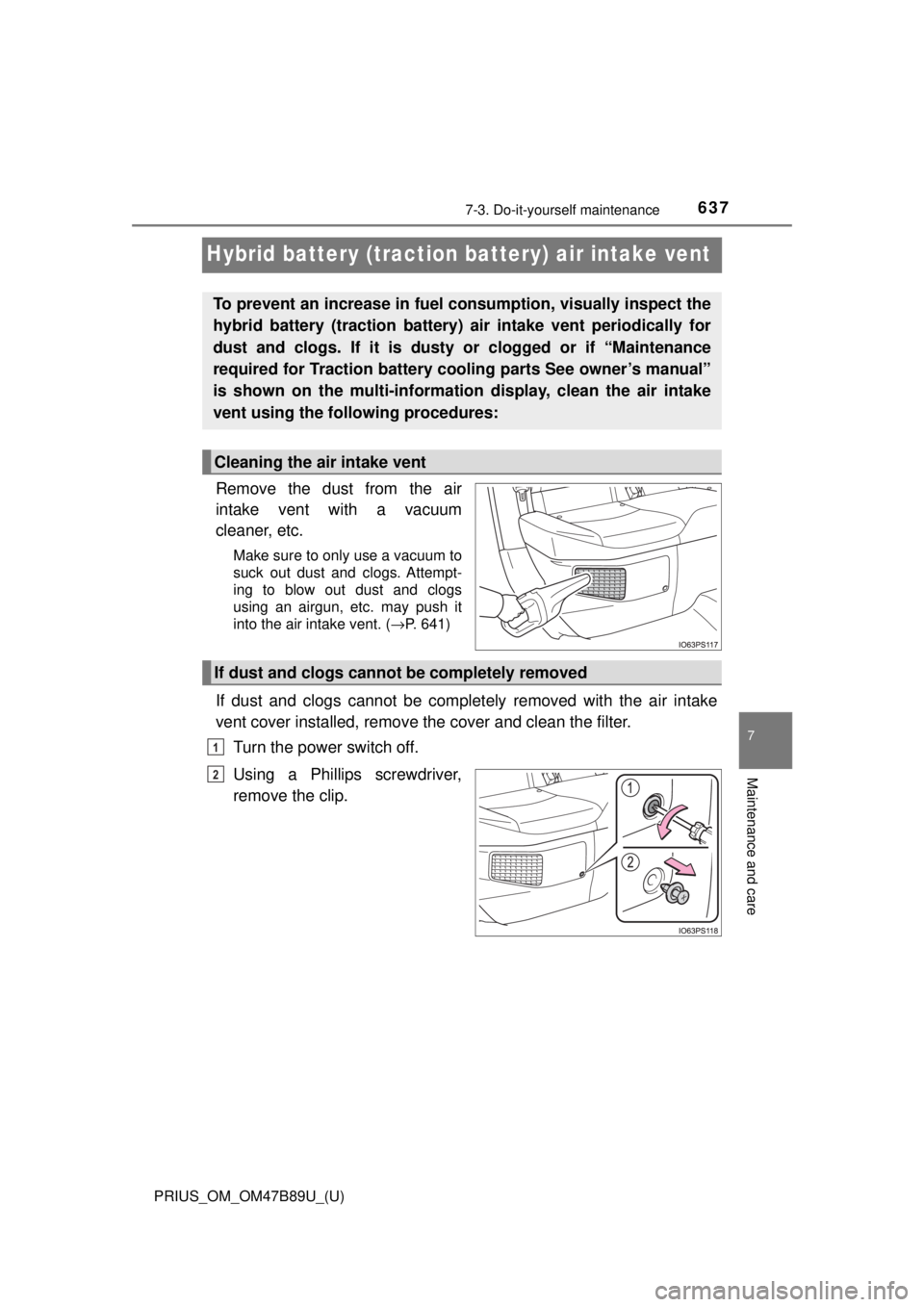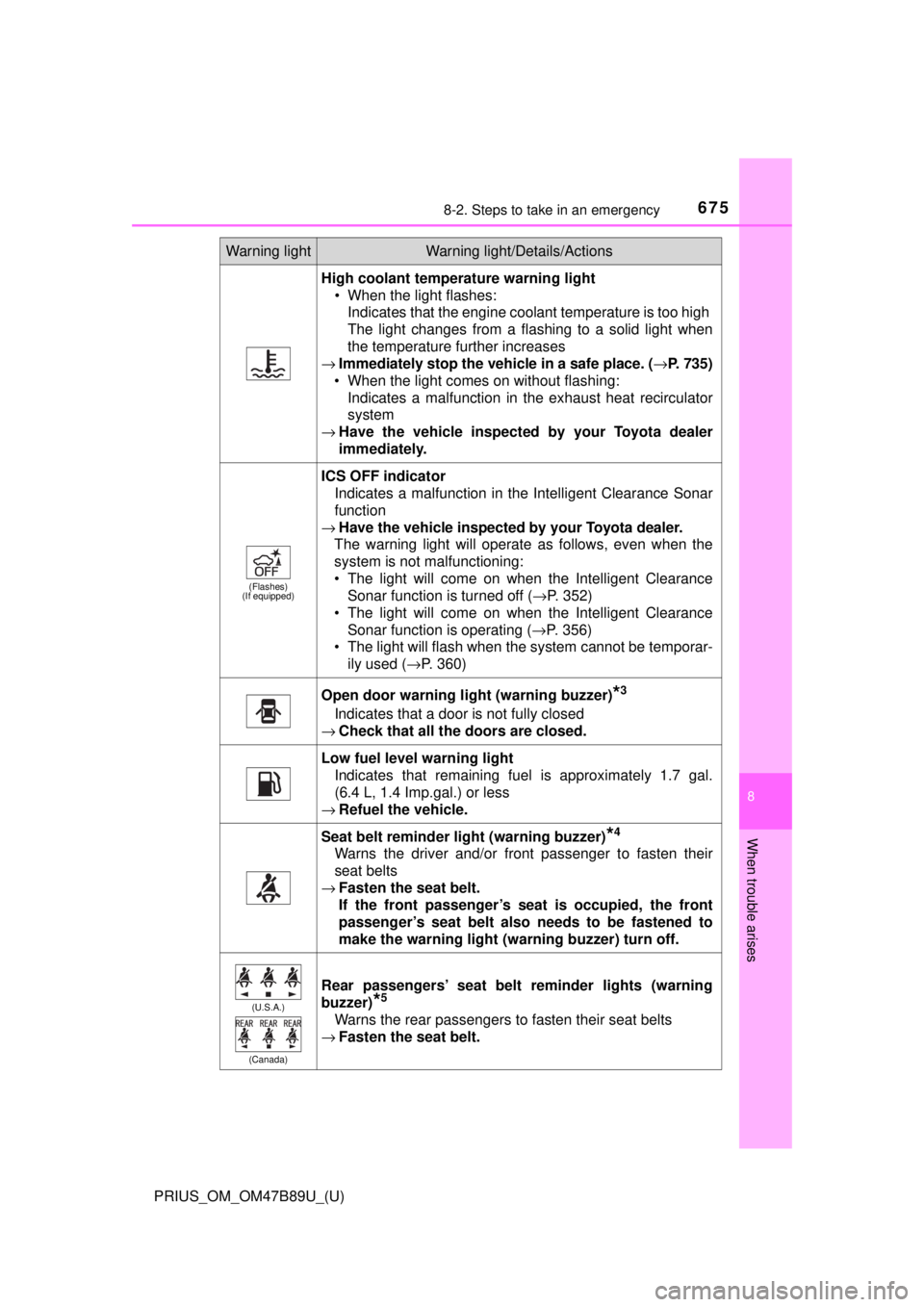2018 TOYOTA PRIUS fuel
[x] Cancel search: fuelPage 597 of 820

597
PRIUS_OM_OM47B89U_(U)
7-2. Maintenance
7
Maintenance and care
Emission inspection and maintenance (I/M)
programs
The OBD system determin es that a problem exists somewhere in the
emission control system. Your vehi cle may not pass the I/M test and
may need to be repaired. Contact your Toyota dealer to service the
vehicle.
● When the 12-volt battery is disconnected or discharged
Readiness codes that are set duri ng ordinary driving are erased.
Also, depending on your driving habits, the readiness codes may
not be completely set.
● When the fuel tank cap is loose
The malfunction indicator lamp comes on indicating a temporary
malfunction and your vehicle may not pass the I/M test.
The error code in the OBD system will not be cleared unless the vehi-
cle is driven 40 or more times.
Contact your Toyota dealer to prepare the vehicle for re-testing.
Some states have vehicle emission inspection programs which
include OBD (On Board Diagnos tics) checks. The OBD system
monitors the operation of the emission control system.
If the malfunction indicator lamp comes on
Your vehicle may not pass the I/M test in the following situations:
When the malfunction indicator la mp still remains on after sev-
eral driving trips
If your vehicle does not pass the I/M test
Page 599 of 820

PRIUS_OM_OM47B89U_(U)
5997-3. Do-it-yourself maintenance
7
Maintenance and care
Tire inflation
pressure
(→ P. 628)• Tire pressure gauge
• Compressed air source
Washer fluid
(→ P. 616)• Water or washer fluid containing antifreeze (for win-
ter use)
• Funnel (used only for adding water or washer fluid)
WARNING
The engine compartment contains many mechanisms and fluids that may
move suddenly, become hot, or become electrically energized. To avoid death
or serious injury, observe the following precautions.
■When working on the engine compartment
● Make sure that the “Accessory”, “Ignition ON” or mileage display
(→P. 108) on the main display and the “READY” indicator are both off.
● Keep hands, clothing and tools away from the moving fan.
● Be careful not to touch the engine, power control unit, radiator, exhaust
manifold, etc. right after driving as they may be hot. Oil and other fluids
may also be hot.
● Do not leave anything that may burn easily, such as paper and rags, in the
engine compartment.
● Do not smoke, cause sparks or expose an open flame to fuel. Fuel fumes
are flammable.
■ When working near the electric cooling fans or radiator grille
Be sure the power switch is off.
With the power switch in ON mode, t he electric cooling fans may automati-
cally start to run if the air condition ing is on and/or the coolant temperature
is high. ( →P. 610)
■ Safety glasses
Wear safety glasses to prevent flying or falling material, fluid spray, etc.
from getting in your eyes.
ItemsParts and tools
Page 629 of 820

PRIUS_OM_OM47B89U_(U)
6297-3. Do-it-yourself maintenance
7
Maintenance and care
Tire valve
Tire pressure gauge
Remove the tire valve cap.
Press the tip of the tire pressure gauge onto the tire valve.
Read the pressure usi ng the gauge gradations.
If the tire inflation pressure is not at the recommended level, adjust
the pressure.
If you add too much air, press the center of the valve to deflate.
After completing the tire inflation pressure measurement and
adjustment, apply soapy water to the valve and check for leakage.
Put the tire valve cap back on.
■Tire inflation pressure check interval
You should check tire inflation pressure every two weeks, or at least once
a month.
Do not forget to check the spare.
■Effects of incorrect tire inflation pressure
Driving with incorrect tire inflation pressure may result in the following:
●Reduced fuel economy
●Reduced driving comfort and poor handling
●Reduced tire life due to wear
●Reduced safety
●Damage to the drive train
If a tire needs frequent inflating, have it checked by your Toyota dealer.
Inspection and adjustment procedure
1
2
1
2
3
4
5
6
Page 637 of 820

637
PRIUS_OM_OM47B89U_(U)
7-3. Do-it-yourself maintenance
7
Maintenance and care
Hybrid battery (traction battery) air intake vent
Remove the dust from the air
intake vent with a vacuum
cleaner, etc.
Make sure to only use a vacuum to
suck out dust and clogs. Attempt-
ing to blow out dust and clogs
using an airgun, etc. may push it
into the air intake vent. (→P. 641)
If dust and clogs cannot be comple tely removed with the air intake
vent cover installed, remove the cover and clean the filter.
Turn the power switch off.
Using a Phillips screwdriver,
remove the clip.
To prevent an increase in fuel consumption, visually inspect the
hybrid battery (traction battery) air intake vent periodically for
dust and clogs. If it is dusty or clogged or if “Maintenance
required for Traction battery cooling parts See owner’s manual”
is shown on the multi-information display, clean the air intake
vent using the following procedures:
Cleaning the air intake vent
If dust and clogs cannot be completely removed
1
2
Page 640 of 820

640
PRIUS_OM_OM47B89U_(U)
7-3. Do-it-yourself maintenance
■Scheduled maintenance of the air intake vent is necessary when
In some situations such as when the vehicle is used frequently or in heavy
traffic or dusty areas, the air intake vent may need to be cleaned more regu\
-
larly. For details, refer to the “Scheduled Maintenance Guide” or “Own\
er’s
Manual Supplement”.
■ Cleaning the air intake vent
●Dust in the air intake vent may interfere with the cooling of the hybrid battery
(traction battery). If the hybrid battery (traction battery) overheats, the dis-
tance that the vehicle can be driven using the electric motor (traction motor)
may be reduced and the fuel consumption may increase. Inspect and clean
the air intake vent periodically.
● Improper handling of the air intake vent cover and filter may result in dam-
age to them. If you have any concerns about cleaning the filter, contact your
Toyota dealer.
■ If “Maintenance required for Traction battery cooling parts See owner’s
manual” is shown on the multi-information display
● If this warning message is shown on the multi-information display, remove
the air intake vent cover and clean the filter. ( →P. 637)
● After cleaning the air intake vent, start the hybrid system and check that the
warning message is no longer shown.
It may take approximately 20 minutes after the hybrid system is started until
the warning message disappears. If the warning message does not disap-
pear, have the vehicle inspected by your Toyota dealer.
WARNING
■When cleaning the air intake vent
Do not use water or other liquids to clean the air intake vent. If water is
applied to the hybrid battery (traction battery) or other components, a mal-
function or fire may occur.
■ When removing the air intake vent cover
Do not touch the service plug located near the air intake vent. ( →P. 85)
Page 675 of 820

6758-2. Steps to take in an emergency
PRIUS_OM_OM47B89U_(U)
8
When trouble arises
High coolant temperature warning light
• When the light flashes: Indicates that the engine coolant temperature is too high
The light changes from a flashing to a solid light when
the temperature further increases
→ Immediately stop the vehicle in a safe place. ( →P. 735)
• When the light comes on without flashing: Indicates a malfunction in the exhaust heat recirculator
system
→ Have the vehicle inspected by your Toyota dealer
immediately.
(Flashes)
(If equipped)
ICS OFF indicator
Indicates a malfunction in the Intelligent Clearance Sonar
function
→ Have the vehicle inspected by your Toyota dealer.
The warning light will operate as follows, even when the
system is not malfunctioning:
• The light will come on when the Intelligent Clearance Sonar function is turned off ( →P. 352)
• The light will come on when the Intelligent Clearance
Sonar function is operating ( →P. 356)
• The light will flash when the system cannot be temporar- ily used ( →P. 360)
Open door warning light (warning buzzer)*3
Indicates that a door is not fully closed
→ Check that all the doors are closed.
Low fuel level warning light
Indicates that remaining fuel is approximately 1.7 gal.
(6.4 L, 1.4 Imp.gal.) or less
→ Refuel the vehicle.
Seat belt reminder light (warning buzzer)*4
Warns the driver and/or front passenger to fasten their
seat belts
→ Fasten the seat belt.
If the front passenger’s seat is occupied, the front
passenger’s seat belt also needs to be fastened to
make the warning light (war ning buzzer) turn off.
(U.S.A.)
(Canada)
Rear passengers’ seat belt reminder lights (warning
buzzer)
*5
Warns the rear passengers to fasten their seat belts
→ Fasten the seat belt.
Warning lightWarning light/Details/Actions
Page 679 of 820

6798-2. Steps to take in an emergency
PRIUS_OM_OM47B89U_(U)
8
When trouble arises
■SRS warning light
This warning light system monitors the airbag sensor assembly, front impact
sensors, side impact sensors (front), side impact sensors (front door\
), side
impact sensors (rear), driver’s seat belt buckle switch, front passenger occu-
pant classification system (ECU and sens ors), “AIR BAG ON” indicator light,
“AIR BAG OFF” indicator light, front passenger’s seat belt buckle switch, seat
belt pretensioner assemblies, airbags, interconnecting wiring and power
sources. ( →P. 36)
■ Front passenger detection sensor, seat belt reminder and warning
buzzer
● If luggage is placed on the front passenger seat, the front passenger de\
tec-
tion sensor may cause the warning light to flash and the warning buzzer to
sound even if a passenger is not sitting in the seat.
● If a cushion is placed on the seat, the sensor may not detect a passenger,
and the warning light may not operate properly.
■ Electric power steering system warning light (warning buzzer)
When the 12-volt battery charge becomes insufficient or the voltage tempo-
rarily drops, the electric power steer ing system warning light may come on
and the warning buzzer may sound.
■ If the malfunction indicator la mp comes on while driving
First check the following:
● Is the fuel tank empty?
If it is, fill the fuel tank immediately.
● Is the fuel tank cap loose?
If it is, tighten it securely.
The malfunction indicator lamp will go off after several driving trips.
If the malfunction indicator lamp does not go off even after several trips, con-
tact your Toyota dealer as soon as possible.
Page 682 of 820

6828-2. Steps to take in an emergency
PRIUS_OM_OM47B89U_(U)
WARNING
■Maintenance of the tires
Each tire, including the spare (if provided), should be checked monthly
when cold and inflated to the inflation pressure recommended by the
vehicle manufacturer on the vehicle placard or tire inflation pressure
label (tire and load information label). (If your vehicle has tires of a dif-
ferent size than the size indicated on the vehicle placard or tire inflation
pressure label [tire and load information label], you should determine
the proper tire inflation pressure for those tires.)
As an added safety feature, your vehicle has been equipped with a tire
pressure monitoring system (TPMS-ti re pressure warning system) that
illuminates a low tire pre ssure telltale (tire pressure warning light) when
one or more of your tires is significantly under-inflated. Accordingly,
when the low tire pressure telltale (tire pressure warning light) illumi-
nates, you should stop and check your tires as soon as possible, and
inflate them to the proper pressure. Driving on a significantly under-
inflated tire causes the tire to overheat and can lead to tire failure.
Under-inflation also reduces fuel effi ciency and tire tread life, and may
affect the vehicle’s hand ling and stopping ability.
Please note that the TPMS (tire pressure warning system) is not a sub-
stitute for proper ti re maintenance, and it is the driver’s responsibility to
maintain correct tire pressure, even if under-inflation has not reached
the level to trigger illumination of the TPMS low tire pressure telltale (tire
pressure warning light).
Your vehicle has also been equipped with a TPMS (tire pressure warn-
ing system) malfunction indicator to indicate when the system is not
operating properly. The TPMS (tire pressure warning system) malfunc-
tion indicator is combined with the lo w tire pressure telltale (tire pressure
warning light). When the system detects a malfunction, the telltale will
flash for approximately one minute and then remain continuously illumi-
nated. This sequence w ill continue upon subsequ ent vehicle start-ups
as long as the malfunction exists. When the malfunction indicator is illu-
minated, the system may not be able to detect or signal low tire pres-
sure as intended.
TPMS (tire pressure warning system) malfunctions may occur for a vari-
ety of reasons, including the installation of replacement or alternate tires
or wheels on the vehicle that prevent the TPMS (tire pressure warning
system) from functioning properly. Always check the TPMS (tire pres-
sure warning system) malfunction te lltale after replacing one or more
tires or wheels on your vehicle to ensure that the replacement or alter-
nate tires and wheels allow the TPMS (tire pressure warning system) to
continue to function properly.